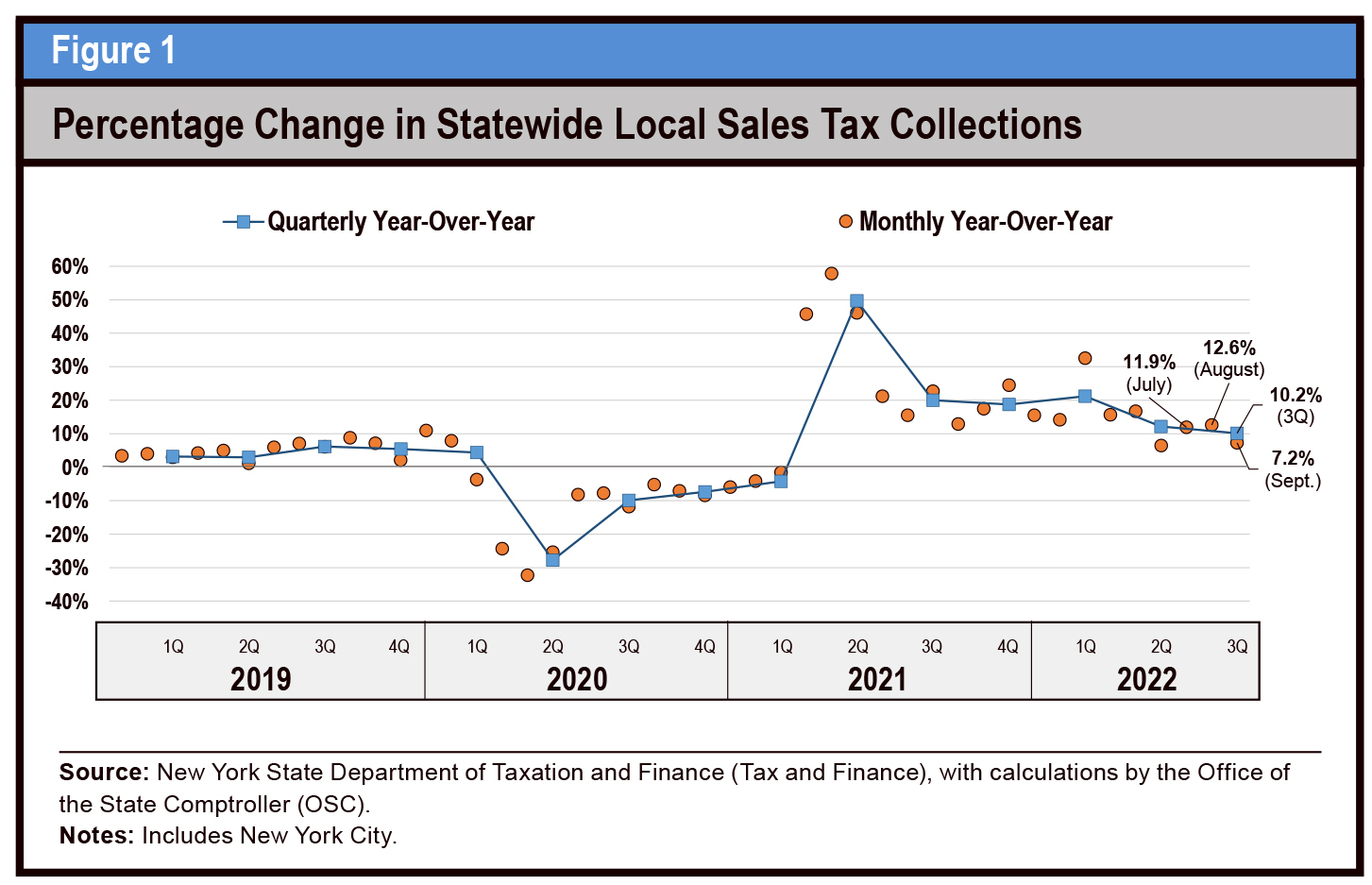
Local government sales tax collections in New York State grew by 10.2 percent in the third quarter of 2022 compared to the same period last year, mostly driven by double-digit growth in New York City.
Total sales tax collections reached nearly $5.7 billion, an increase of $529 million, according to a report released by State Comptroller Thomas P. DiNapoli last week.
However, it is the second straight quarter that year-over-year growth did not keep pace with inflation for counties and cities outside of New York City.
“New York City’s sales tax growth in the third quarter, after relatively weaker collections in 2020 and 2021, bolstered overall growth for the state,” DiNapoli said in a release accompanying the report. “Most local governments are experiencing sales tax revenue growth, even as they struggle with higher costs from inflation, just like consumers and businesses.”
While local sales tax collections from July to September rose by double digits for the sixth straight quarter, local governments are contending with higher costs from inflation, which was 8.3 percent nationally. Adjusting for inflation, year-over-year growth in the value of sales tax revenue for the third quarter was about 1.8 percent, according to the report.
Overall collections for the counties and cities outside Manhattan grew by 5.3 percent, to $2.9 billion. However, when adjusted for inflation, these collections are worth slightly less than the $2.8 billion collected in the same quarter last year, the comptroller said.
DiNapoli’s report notes that the third-quarter collections of several counties outside of New York City were less than what they would have been had they not opted to implement a local component of the state’s “gas tax holiday.” Suffolk County adopted the holiday, which runs through the end of the year.
Suffolk County was among those that saw just a moderate increase in sales tax revenue, up 3.6 percent over last year’s third quarter, with revenue of $500.9 million in 2021, compared to $519 million this year.
Looking back, the slender increase and the inflation effect pale in comparison to what County Executive Steve Bellone described as a “disaster” when the COVID pandemic forced the shuttering of nonessential businesses in 2020.
For the months of March and April in 2020 Suffolk County’s sales tax revenue was down $36.4 million compared to 2019, with April seeing a decrease of $29.8 million over the prior year.
In April 2019, the county collected $111.4 million in sales tax. During the early months of NY PAUSE in 2020, April’s sales tax revenue tallied $81.6 million, for a reduction of 26.7 percent. In March, the dip was less severe, down 5.4 percent, from $130.2 million in 2019 to $123.6 million in 2020.
The revenue figures plummeted again that May. The county collected $72.9 million, compared to $109.7 million in May 2019, for a reduction of 33.5 percent. By June, the end of the second quarter of 2020, revenue was down 21.4 percent, with collections of $297.6 million, compared to the prepandemic $378.6 million.
By the third quarter of 2020, an uptick of 2.8 percent began, as the COVID-prompted shutdown began to lift. The county ended 2020 with a rebound of 11.3 percent, going from $372.5 million in 2019 to $414.4 million for that last quarter of the year in 2020.
In 2020 statewide, local sales tax collections declined by 11.8 percent, or $225 million, for the single month of September 2020, compared to the same month in 2019.
Returning to the present, DiNapoli noted that the higher cost of goods, which come with higher tax collections, was a contributing factor to the uptick in revenue. However, he also noted that, due to the higher costs, local governments, like consumers, are able to actually buy less.
Not everyone is keeping their wallets firmly closed. Reuters reported that shoppers in the United States spent a record $9 billion on Black Friday, a traditional day for shopping post-Thanksgiving sales.